

"The mission and goal of the Golden Gringo Chronicles is to provide,
in an
informative and entertaining way, insight into
living
the
Costa Rican
experience as an expat."
1. Broken News: GG Mea Culpa; Tico #5,000,000; 2019 Government Budget; General Strike in Costa Rica Unresolved, Nicaragua Status - Has Crisis Peaked?; Independence Day 2018.
2. Rumble and Weather Talk: September Rainfall Heavy; Poás National Park Reopens
3. Feature: Confused Cocodrilos (Dealing With Trans-Gender Crocodilian Problems)
4. ¿Que Es Eso? Department: Turquoise Tuber, Purple People Potato Easter Maybe?
5. Feature: Sandia (The Ubiquitous Watermelon of Costa Rica)
6. Health Stuff: More on Those Health Foods: Coffee, Chocolate and Red Wine.
7. GGC Bookshelf and More: Books, Golden Gringo T-Shirts and Coffee Mugs from GGC Publications as Well as Suggested Books from the Quepos-Manuel Antonio Writers Group.
8. What's-in-a-Word: Answer to ¿Que Es Eso?, Etymology of Sandia, Crocodilian, Ubiquitous
9. ROMEO Corner: Restaurant "Z" at Marina Pez Vela
Wisdom of the Ages

GG Mea Culpa
 |
| GG Taking a Guilt Trip |
Well GG finally did it; after 120 editions over ten years I put out the monthly email for the September edition with the wrong link. Then I doubled down on the error by copying the core of the link to all the other links in that edition, causing all the links in that edition to be faulty. Bad boy, bad boy GG.
Unfortunately I was unable to put out a correcting email because the bulk email service I use (MailChimp) allows only 2,000 emails per month (free) and I had already reached 1,504 with the first email. This service has helped the Chronicles grow from 359 subscribers in September 2014 to 1,504 this September, in exactly four years.
Perhaps you know, or don't know, but trying to do this through Outlook is almost impossible as they allow only 100 addresses per email, which would require 16 email setups for my current level of subscribers. MailChimp is a good and capable outfit and I will need to have a discussion with them soon on what happens when we reach 2,000 subscribers (of course, the answer is likely I'll have to pay something monthly).
The bad link I put out was http://www.bobnormand.com/GGC/eseptember2018.html. That gem will get you a 404 error or "File can't be found" message, which is the right response because there is no such file. The correct link is:
http://www.bobnormand.com/GGC/e121september2018.html.
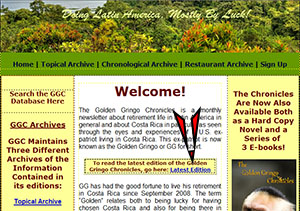 |
| www.goldengringo.com Front Page Showing Link to Latest Edition |
Note how the "121", the edition number, is in the correct address and was missing in the original address. Try the new link, it works, I tested it. By clicking above you can read all of last month's Chronicle if you missed it earlier.
Please note that there is another and quite easy way you can get to the current edition and, for that matter, to any of the 121 editions. Simply go to www.goldengringo.com and click on the link labeled "Latest Edition" which is shown on the photo right. All the editions to date, latest edition first, will be listed along with summaries, each edition links directly to the full write up.
In addition to the edition archive, another resource available to you is the Topical Index Archive where you'll find links to some 250 feature articles previously published in the Chronicles and grouped into 14 areas of interest, to wit: 1) About Quepos & Manuel Antonio, 2) Agriculture, 3) Costa Rica Wildlife, 4) Costa Rican Culture, 5) Getting Residency, 6) Golden Gringo University, 7) Health/Medical, 8) History of Costa Rica, 9) Legends of Costa Rica, 10) The Beaches, 11) Weather and Tremor Tales, 12) Other Places in Costa Rica, 13) Other Latin American Countries and 14) Miscellaneous). A link to the Topical Index Archive is also available on the website and on every (correct) monthly email.
Sorry about the mess-up in September; I'll try to do better from here on out and I thank you for your loyal readership.
Tico #5,000,000
 |
| Here I Am Doc |
 |
| Catch You After a Few Winks Amigos |
Señor Eithan Jesús Brenes was born at 9:27 pm On September 1, 2018 in San Vincente de Paúl Hospital in Heredia, officially becoming the 5,000,000th living Costa Rican to populate this land. The parents are Madelyne Alvarado Calvo, 27 years of age, a first-time mother and Reinier Brenes Calvo, 31. The family lives in Varablanca, a small town about 15 miles north of Alejuela in the Central Valley.
There has been a remarkable growth in population in Costa Rica that GG has noted before. From 1947, the year the civil war ended and the current republic began, the country has gone from 726,000 people to 5,000,000. For perspective, if the U.S. had grown at the same rate during that period the current population of gringoland would be close to one billion (it's actually about 326 million).
First reports are that young Eithan has been crying for a plate of gallo pinto laced with lizano sauce and a futbol with a La Liga (Alejuela) imprint on it. Patience young man, all will be right in good Tico time amigo.
2019 Government Budget
The Chronicles has mentioned before that the biggest challenge facing Costa Rica at this time is the growing financial deficit. Government officials here very rarely show the operating deficit as a percent of expenditures; they prefer to report it as a percent of Gross Domestic Product which of course is a significantly smaller number that an operating deficit.
 Recently the proposed budget for 2019 was sent to the legislature. It calls for a total 17.5% increase in expenditures(!) but if you dig into the numbers you'll find that just about all of the increase is the result of increases in debt payment. The growth in this line item alone is pegged at 53%(!) versus last year. The deficit, measured as a percent of expenditures, is 41.6%(!!) on a budget of $19 billion ($8 bil in the hole). But as a percent of GDP it's only 7.9%.
Recently the proposed budget for 2019 was sent to the legislature. It calls for a total 17.5% increase in expenditures(!) but if you dig into the numbers you'll find that just about all of the increase is the result of increases in debt payment. The growth in this line item alone is pegged at 53%(!) versus last year. The deficit, measured as a percent of expenditures, is 41.6%(!!) on a budget of $19 billion ($8 bil in the hole). But as a percent of GDP it's only 7.9%.
This is the problem our new president, Carlos Alvarado, inherited and his ability to confront it will define his presidency. A panoply of new taxes and collection techniques designed to improve efficiency of collecting tax revenues is now being discussed in the legislature. Also under discussion is a rollback of some of the exceedingly generous benefits public employees have (like three months Aguinaldo as opposed to one for non-public employees, extreme pensions, some up to two million colones a month - call it $3,500) etc. Preserving this largess is one of the reasons for the strike.
Righting the sinking financial ship of state will not be an easy correction in Costa Rica's fiscal health but one very much needed.
General Strike
In the middle of the financial crisis, an alliance of public employee unions decided to call a "general" strike.
It began on Monday, September 10 with the goal of it being an "indefinite" strike supposedly as a protest of the new fiscal plan being put forth by the government. That plan was an attempt to grapple with the run away debt problem caused by the large operating deficits the government has been running for several years now. As mentioned above, the planned deficit in the budget for 2019 will run about 42% of the budgeted expenditures.
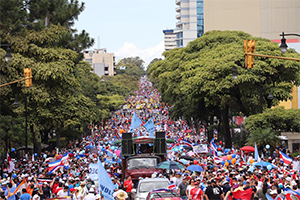 |
| Avenida Segundo During Strike 13 September |
During the first three days of the strike (September 10-12) the demonstrators, which included members of all major public employee unions, caused roadblocks, highway shutdowns and even train blockages. That effectively shut down transportation in San José and to a lesser degree elsewhere in the country.
Sporadic violence broke out at some of the demonstrations in both San José and Limón prompting President Alvarado at one point to comment:
"The events recorded yesterday in Limón and today and in front of the Legislative Assembly are deplorable and are far from the Costa Rican tradition. With deep sadness, we have seen the sabotage of public goods to try to prevent the gas (he's talking about natural gas which is 100% imported here - ed.) from reaching the kitchens of homes or hospitals, the retention of a public train affecting its passengers, the aggression against officers of the Public Force or members of the press, neither you nor I want that in Costa Rica." Later, he added: "The disposition to dialogue is still present. The door is open. The table is ready. The government is still open to dialogue but will do so when strikes [stop] and the climate of peace prevails."
By mid-month after a full week of the strike and demonstrations the outlook was not good:
The Social Security Service (CCSS) said that last Friday (8 Sept) almost half of the regional health clinics that joined the strike on Monday had resumed operations; however there were 1,201 scheduled surgeries canceled and 38,921 appointments that did not receive attention.
The disorder also had an effect on the Independence Day celebration as noted below.
Nicaragua Status - Has Crisis Peaked?
Due to the ongoing and crescendoing struggle between Nicaragua's president Daniel Ortega and rebellious student groups, Costa Rica recently peaked in the number of Nicaraguans requesting refugee status here. In June and July refugee applications totaled over 10,000 each month. Compare that to the total of 6,300 applications in all of 2017 and the 2,200 three years ago in all of 2015. For reference, the population of Nicaragua is estimated to be about 6.15 million versus Costa Rica at about five million.
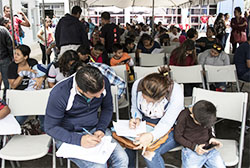 |
| Nicaraguans Filling Out Refugee Claims in San José |
The number of refugee applications dropped somewhat in August with about 5,000 new ones but it's still more than twice, in one month, what it was for an entire year three years ago. On a population ratio basis, the monthly 10,000 number in Costa Rica would be like the U.S. experiencing a monthly influx of 650,000, the population ratio of the U.S. to Costa Rica being about 65 to 1 (the land area ratio is 193 to 1).
The U.N. Refugee Agency has pledged financial and organizational support to Costa Rica and encouraged other nations to do the same. Costa Rican authorities are working overtime to keep up with the flow of people but so far Tico authorities say the problem has yet to reach their definition of a crisis level.
In essence the cold standoff between the government and the protesters is just that, with no significant progress reported on a long term solution such as might be provided by early elections.
On another front Sr. Ortega "demanded" that Costa Rica release to Nicaragua a list of all those who have made refugee applications along with the reason they gave for justifying refugee status. Costa Rican authorities diplomatically told El Presidente to go take a hike in the rainforest.
Independence Day
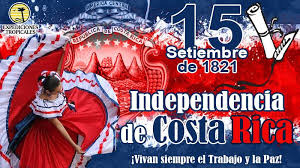 September 15 is Independence Day in Costa Rica as it is in much of Latin America. The date commemorates the day in 1821, a year when most of the countries previously subjugated by Spain broke their ties with the mother country. Latin American countries at that time were encouraged by the success of the revolution and independence from England that occurred in the United States a few decades earlier. For the month of September in every year since the revolution, the red, white and blue bunting comes out, costumes and flags proliferate, food vendors are everywhere; it's fiesta time!
September 15 is Independence Day in Costa Rica as it is in much of Latin America. The date commemorates the day in 1821, a year when most of the countries previously subjugated by Spain broke their ties with the mother country. Latin American countries at that time were encouraged by the success of the revolution and independence from England that occurred in the United States a few decades earlier. For the month of September in every year since the revolution, the red, white and blue bunting comes out, costumes and flags proliferate, food vendors are everywhere; it's fiesta time!
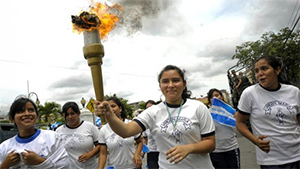 |
| Independence Torch Starting in Guatemala |
Guatemala being the seat of the Spanish Vice-Royalty that governed Costa Rica before independence, the word of this event in 1821, as well as the declaration itself, had to come by personal carrier. It took over a month to reach Costa Rica, arriving October 13, 1821 (no FedEx, Amazon or Twitter then amigos).
In recent years a ceremony was created by which a torch is carried by young people all the way from Guatemala through the countries that were affiliated with the Guatemala Vice-royalty and who also declared independence at that time (El Salvador, Honduras and Nicaragua). The current pilgrimage down to Costa Rica is timed so that the torch reaches Cartago, the first capital of Costa Rica, on September 15. The torch was declared a national symbol in 2005.
Unfortunately because of the national strike in Costa Rica this year and resulting unrest the torch run was stopped in Esparza, a town near Puntarenas. The torch was extinguished and flown to Cartago because of concerns for the safety of the runners. This was the first time in the history of the ceremony that the torch was unable to arrive by land and by runner. The arrival ceremony was also poorly attended as a result.
You may have noticed that in three more years, 2021, the country will be celebrating it's 200th anniversary of independence. I'm sure that one will be a blowout, meaning a big, happy celebration, let's hope it will not be a "blowout" in the sense of requiring the extinguishing of the torch again.
¡Pura Vida!
September Rainfall Heavy
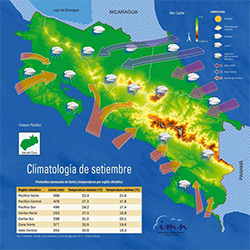 It was noted in last month's Chronicle that some 22 Tropical waves had swept over the country this year as of August 1 causing problems with flooding and road damage. As of September 7 the Tropical Wave count had reached 35 with at least two more months of rainy weather expected.
It was noted in last month's Chronicle that some 22 Tropical waves had swept over the country this year as of August 1 causing problems with flooding and road damage. As of September 7 the Tropical Wave count had reached 35 with at least two more months of rainy weather expected.
Being a relatively small and narrow country in the center of the Central American isthmus, we get bands of rain storms crossing the country from both directions although the ones coming off the Caribbean tend to be stronger. The chart to the left shows this pattern and also includes a table showing the historical rainfall average for the month of September.
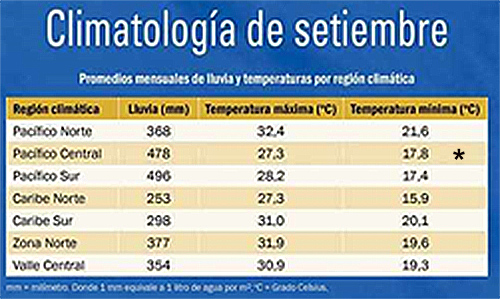 I reproduced and expanded the rainfall table in the figure above to the version on the right in order to make it more readable, although the expansion process left it a bit blurry.
I reproduced and expanded the rainfall table in the figure above to the version on the right in order to make it more readable, although the expansion process left it a bit blurry.
Note that the Pacific Central (noted by *; think Quepos) and Pacific Sur (think Osa) lead the pack in rainfall. A typical September rainfall (lluvia) here is listed at 478 mm (millimeters) or almost 19
inches. And that's without hurricanes which usually pass north of us.
Cheer up amigos, the dry season is only a couple of months away.
Poás National Park Reopens
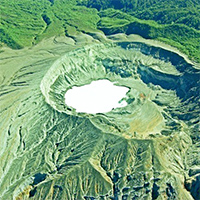 After sixteen months of being closed as a result of seismic activity, the National Park at Volcan Poás finally reopened on the first of September. The park received 1,550 visitors during the first three days of renewed operations.
After sixteen months of being closed as a result of seismic activity, the National Park at Volcan Poás finally reopened on the first of September. The park received 1,550 visitors during the first three days of renewed operations.
Park authorities noted that security for visitors has been improved and that: "...the security system includes clear evacuation routes and better management of the number of tourists entering the park... as well as shelters, protection devices and gas meters in real time to safeguard the visitors and employees in the event of an emergency." That couldn't be a clearer message on why we need to respect alerts and warnings..
Check Out Recent Earthquakes Around the World Posted by the U.S. Geodetic Survey: Recent Quakes |
Search the Golden Gringo Chronicles Archives for Topics That Interest You
You can use our Archives to search for anything that has been written in more than 220 feature articles of the Golden Gringo Chronicles plus find Broken News items and ROMEO restaurant reviews. Enter your topic or item to search in the Google Search Routine below and follow the links offered from the search results. Suggestion: Enter only a simple, precise and unique as possible keyword or two in order to narrow the number of references retrieved:
Readers: Our publication is open to suggestions regarding future articles and will accept pieces written by others but we reserve the right to decline anything that the editorial staff (that's GG) thinks is inappropriate for this format. Send proposals, comments, suggestions, ideas, meaningless statements and jocular observations concerning the Chronicles to GG here: gg@goldengringo.com.
A recent headline in a regional electronic newspaper read like this:
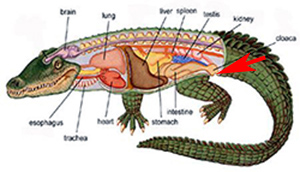 |
| Parts of a Crocodile (Cocodrilo in Spanish) |
"How Do You Tell The Sex of a Crocodile? (Carefully; They’re Having Trans-gender Problems)" Now that's a headline. Of course I felt compelled to read and find out more.
The article went on to explain how you determine the gender of a crocodile, explaining in a way that a third grader might describe as "yucky". That is you stick your finger in a certain opening on the underside of a mature croc called a "cloaca" (klo-ah-kah) and “If there’s a structure there, it’s a boy. If there isn’t a structure, it’s a girl.” Methinks it's the kind of thing best left to professional researchers. And everyone knows (well maybe most people know) that male crocodiles are more aggressive than females and I suspect they don't like their cloaca messed with.
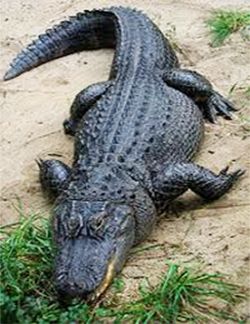 |
| Mr. Alligator |
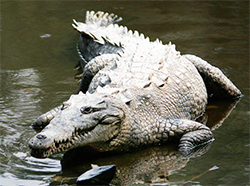 |
| Señor Cocodrilo (Crocodile) |
First let's remember that the American crocodile is part of the crocodilian family which includes both the crocodile and the alligator. Our crocs down here in Central and South America more than hold their own in size, weight and aggressiveness compared to a North American alligator. A typical fully grown male croc is about two feet longer than its alligator counterpart and about 10-15% heavier (880 vs 790 lbs). Fully grown females tend to be 10-20% shorter and lighter than their male counterparts for both types.
In Costa Rica, crocodiles have been measured achieving lengths up to almost 20 feet and weighing almost 2,000 lbs. Nevertheless, even that is not the world record as that honor belongs to a rogue croc in the Philippines named Lolong that measured in at 6.4 meters/21 feet and weighed 1,075 kilos/2,368 lbs dripping wet. Lolong had killed two people before they were finally able to subdue him.
And check out those photos to the right. The kind of alligator shown in the top photo is a frequent visitor to the backyards of Florida residents who live in the southern half of the state. I remember them well as I lived there for ten years and we even had one occasionally in the pond outside my condo. The gator is a formidable lizard that I wouldn't play with or take a chance with. It's "bite force" has been measured in excess of 2,000 psi.
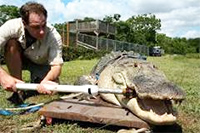 |
| It's Mine Dude, Back Off! |
But he does look a little less frightening than the croc in the lower photo above, right which has a longer, more powerful jaw with even more teeth and a more pronounced spiked back that makes it look like a dinosaur. And, oh yeah, the bite force of a mature crocodile has been measured in excess of 3,700 psi. Talk about hazardous work!
So these oversized geckos are both deserving of caution. But let's get back to the trans-gender problem.
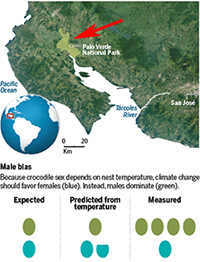
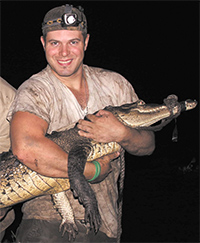 |
| Chris Murray and Friend |
A gentleman by the name of Chris Murray came to Costa Rica in 2012 as a doctoral candidate at Auburn University. At the behest of his thesis adviser Chris took up residence near Costa Rica's Palo Verde National Park, located at the northern end of the gulf of Nicoya (map right) to study crocs.
The project included routine (yucky) cloaca examination of some 500 crocodilians residing at or near the park. The researchers expected to find evidence of a shift toward more females than males in the population simply because it is known that the natural gender selection or development process of crocodiles leans toward the production of more females when nest temperatures increase. Temperatures in this region have been measured as increasing some 2.5 C/4.5 F during the last few decades of global warming.
They encountered the opposite finding. Where they would have predicted at least equality in gender or even more likely a predominance of females over males, instead they found a strong predominance of males over females (see the bottom of the map above, right). The green circles are male and the blue ones female. While they expected a nearly two to one female to male ratio they found a male to female ratio of four to one.
Later analysis of tissue samples of the crocs indicated the presence of a strong hormone, 17α-methyltestosterone, also known simply as "MT". MT has been (ab)used for decades by body builders to "bulk-up" and has been shown to have a skewing effect towards males when crocodile eggs were treated with the compound. Nevertheless several studies from other sources conclude that MT does not have a demonstrated negative effect on humans, certainly not like the gender effect on crocs.
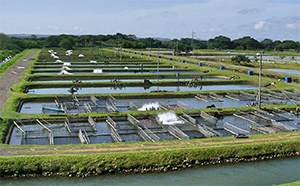 |
| A Costa Rican Tilapia Farm |
MT is also widely used by fish hatcheries such as Tilapia farms to "bulk-up" the fish for sale. Tilapia product is a huge market; in the U.S. alone in 2017 it accounted for 475 million pounds. It is known that there are several Tilapia farms in the general area of the Palo Verde park but the occasional interaction of a croc with farm isolated fish would not seem to be enough to cause the overall effect.
More research is underway to determine if there is another, unknown source of MT or just what is the means by which MT is getting into the reptiles. Even though crocodiles sometimes sneak into a Tilapia farm and steal a fish or two, the incidence of this is not thought to be high even to cause the skewed result that has now been exposed.
In the meantime Chris and his team will continue to study cocodrilos, albeit carefully, and try to find the source of the MT that's causing this imbalance.
¡Solo Bueno!
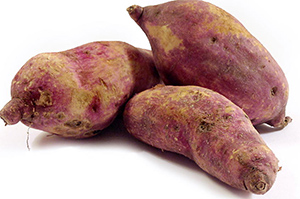
A Sick Potato Perhaps?
Is It a Purple People Eater?
A Turquoise Tuber from the Jungle?
Answer in What's-in-a-Word section below.
¡Solo Bueno!
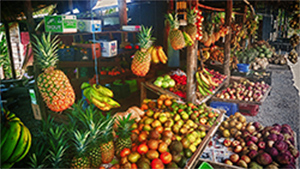 |
| There Are Some Costa Rican Fruit Stands You Just Don't Want to Leave |
The Chronicles has written of many fruits, some indigenous, some just having been grown here a long time including Apples,. Bananas, Pejibaye (fruit of the peach palm that tastes nothing like a peach), Mangos, Mamon Chinos (lychee nuts), Papaya, Maracuya/Grenadilla (Passion Fruit), Pineapple and several others.
For a complete list of the fruits previously written about with links to their corresponding articles go here: Fruits of Costa Rica.
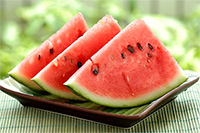 Sandia is the Spanish word for watermelon, a widely-grown fruit in Costa Rica often relegated to minor importance yet it's an integral part of daily life here. I can't think of a restaurant, juice stand (of which there are many), or supermarket in all of Costa Rica that doesn't offer sandia, a drink made from it alone or in mixtures with other fruit. It also appears as a simple garnish on various plates either alone or combined with other fruits and is always fresh and delicious. And, oh yeah, it's very healthy for you (more on this below).
Sandia is the Spanish word for watermelon, a widely-grown fruit in Costa Rica often relegated to minor importance yet it's an integral part of daily life here. I can't think of a restaurant, juice stand (of which there are many), or supermarket in all of Costa Rica that doesn't offer sandia, a drink made from it alone or in mixtures with other fruit. It also appears as a simple garnish on various plates either alone or combined with other fruits and is always fresh and delicious. And, oh yeah, it's very healthy for you (more on this below).
Their is a strong export market for Costa Rican-grown sandia. This market has been increasing significantly in recent years. Although CR sandia exports to the U.S. represent only about 2% of total U.S. consumption that turns out to be about 10,300 tons of fruit worth about $3 million. Costa Rica shipped total exports of almost 38,000 tons of the fruit in the first five months of this year (up 22% over 2017), much of it going to Europe and with almost 40% of that or 14,200 tons going to the Netherlands, the biggest customer (dat is heerlijk mijnheer).
Male vs Female - Size Matters
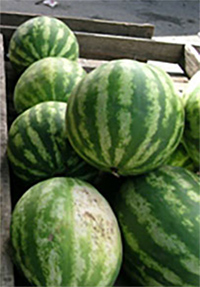 |
| Costa Rican Watermelon |
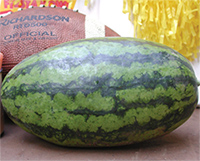 |
| Northern Watermelon (Talking About the Green Oval) |
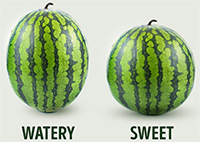 |
| Male versus Female |
One of the things I noticed early about Costa Rican watermelons was that they were somewhat smaller and almost perfectly round spheres whereas I had become used to larger, oblong shaped melons in the U.S. (see photos left and right). The experts say that we should select medium sized melons for the best taste and ripeness.
¿Porque es eso, amigo? Why is that friend?
I may have found the answer but if I were you amigo I wouldn't bet the farm on it. I learned that watermelons come in male and female versions. The males are more oblong than the females, say the experts and it also happens to be that the males are more watery while the females are sweeter (ok gals, no snarkey comments please).
So, to inquisitive minds (or maybe just idle ones), does that mean the males have been separated from the females and shipped overseas leaving all those round females behind?
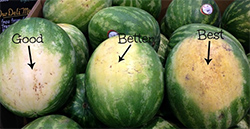 Let's go on. So, if it's important to select a watermelon that is perfectly ripe, how do you do that? Fear not, GGC has done the research and has the answer for you.
Let's go on. So, if it's important to select a watermelon that is perfectly ripe, how do you do that? Fear not, GGC has done the research and has the answer for you.
The photo left shows you how to judge the ripeness and readiness of a watermelon. Those in the know say you should look at the white spot (don't worry about this spot which is also called a "field spot"; that's the place where the melon rested on the ground). The "...best watermelons have creamy-yellow or even orange-yellow spots. Go for the gold." It's easy to get a ripe, luscious watermelon when you know what you're looking for.
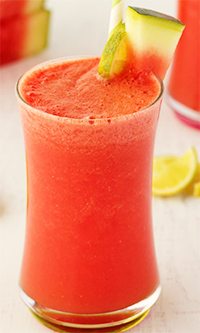 |
| Watermelon Smoothie |
Once you've selected a good melon it is very hard to resist the temptation to immediately make a smoothie with sandia as the base. By itself, liquefied with some water, it makes a great and refreshing drink. To get it even richer some aficionados add milk or liquid yogurt in place of the water. Or really go all out and try combinations with other fruit such as pineapple (my favorite), papaya or strawberries. Keep trying different combinations, who knows what you'll come up with.
Nutrition
Remember that watermelon, though greater than 90% water (at least the red fruit part that is) is a good source of vitamins and minerals such as: Vitamins A, C and B-6, as well as potassium, magnesium, fiber, iron and calcium.
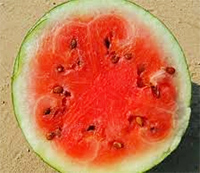 |
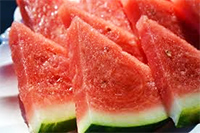 |
| Really Red is Best |
Even more important is the fact that the red portion contains relatively high levels of lycopene (also found in carrots). Says a prominent nutritionist: "Lycopene has been linked with heart health, bone health and prostate cancer prevention. It's also a powerful antioxidant thought to have anti-inflammatory properties. To really maximize your lycopene intake, let your watermelon fully ripen. The redder your watermelon gets, the higher the concentration of lycopene becomes."
The white portion of the rind is also healthful as it contains amino acids including cirruline which promotes blood flow, leading to cardiovascular health and improved circulation. Another factor: "Recent studies have found that watermelon seeds are also wonderfully nutritious, especially if they are sprouted and shelled. They are high in protein, magnesium, vitamin B and good fats, according to an analysis by the International Journal of Nutrition and Food Sciences". OK, but I'm not sure I can swallow them after spending so many years spitting them out; and it certainly is less fun.
Watermelon contains natural sugars and those suffering with more severe cases of diabetes (Type I for example) need to be cautious about eating watermelon, but check with your doctor on how much, if any, you should eat. The Glycemic Index (GI) of watermelon is 72 and anything over 70 should be considered with caution by diabetics according to nutritionists. Another measure is Glycemic Load which measures GI plus carbohydrates. GL under 10 is considered low and Watermelon has a GL of 2. So it fares much better by that measure.
The overall conclusion with regard to health is that watermelon is very healthful for most people but should be used with caution by diabetics. For most of us sandia represents a great addition to the diet that is refreshing, delicious and healthful all at the same time.
¡Pura Vida!
| Note: The information given in this section is offered as news information only and does not indicate GGC confirmation or denial of the accuracy of the treatment or a recommendation to pursue it, nor can we or do we guarantee the efficacy of the results nor validity of the conclusions proffered. (How's that for a disclaimer amigos?) |
Health Foods: Red Wine, Coffee, Chocolate
Whodathunkit? Over the last five years or so GG has been issuing forth strong guffaws (gotta look up the origin of that word) as mounting evidence from a variety of sources has indicated that coffee and chocolate might actually be good for you. In the 70's, 80's and 90's, coffee and chocolate were badmouthed often by nutritionists and others.
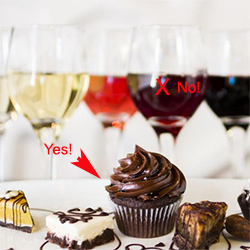 Of course we need to remember that what is being suggested is that the best chocolate for health purposes is the real dark version without added sugar, of which Montezuma used to consume great quantities. No moderation was had by this Aztec king (as many as 100 cups of chocolate per day).
Of course we need to remember that what is being suggested is that the best chocolate for health purposes is the real dark version without added sugar, of which Montezuma used to consume great quantities. No moderation was had by this Aztec king (as many as 100 cups of chocolate per day).
And we're also taking about moderation in coffee drinking (max three cups per day) and even more caution in its use if you have high blood pressure. And for those that must refrain from red wine or other alcoholic beverages, like GG, we'll have to stick to coffee and chocolate. (we might also slip in a bowl of ice cream here and there).
The latest study to emerge comes from the Warsaw University of Life Sciences in Poland where the lifestyle of some 68,000 men and women aged between 45 and 83 were analyzed over a 16-year period. Their conclusion:
"The results revealed that those participants who followed an anti-inflammatory diet, which includes regularly eating foods such as fruits, vegetables, low fat cheese, and nuts while also consuming treats such as tea, coffee, chocolate and moderate amounts of red wine and beer, had an 18 per cent lower risk of death by any cause."
I don't know about you amigos by I've always been uncomfortable with phrases such as "...per cent lower risk of death". The risk of death as I understand the process is 100%. Perhaps they mean you can extend your life expectancy by 18% which would mean the average of 80 years would increase to about 94?
Bring on the chocolate and coffee amigos.
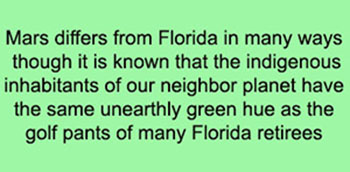
from an article: “Best Place to Retire; Florida, Costa Rica or Mars"
 GGC Publications Group is the parent organization that publishes the Golden Gringo Chronicles as well as a number of books and paraphernalia related to the Chronicles and Costa Rica. The GGC Bookshelf also includes works from a number of other authors that belong to the Quepos-Manuel Antonio Writers Group in which GGC has been a founding member.
GGC Publications Group is the parent organization that publishes the Golden Gringo Chronicles as well as a number of books and paraphernalia related to the Chronicles and Costa Rica. The GGC Bookshelf also includes works from a number of other authors that belong to the Quepos-Manuel Antonio Writers Group in which GGC has been a founding member.
Here are the books currently on our bookshelf:
 |
 |
 |
 |
| The Chronicles as a Narrative | Mariposa - English | Mariposa - Español | Small Business Guide |
| Read More | Read More | Leer más aquí | Read More |
 |
 |
 |
 |
| Overcoming Drinking | Making Time Count | Spiritual Love Connection | Murder or Suicide? |
| Read More | Read More | Read More | Read More |
 |
There's Room for More on the QMA Writers Group Bookshelf | There's Room for More on the QMA Writers Group Bookshelf | There's Room for More on the QMA Writers Group Bookshelf |
| Getting Around the Capital | |||
| Read More |
All of the above books are available on Amazon.com and the "Read More" links above will lead you to them. You can also find them all on our GGC Publications Page. And here is the link to GG's Amazon Author Page: Bob Normand Author Page
GGC Publications also offers some accessories and paraphernalia related to the Chronicles and with Costa Rican themes, to wit;
 T-Shirts:
T-Shirts:
a. Golden Gringo Chronicles with Logo,
b. Official Golden Gringo with Monkey on Banana Hammock,
c. ¡Quepo en Quepos! ("I Fit In Quepos!") with Photo of Quepos,
d. Wanna Monkey Around? - Come on Down! with Photo of White Face Monkey,
e. It's OK to be Slothful with photo of Three-Toed Sloth.
The t-shirts are available in several colors, styles and sizes. See them HERE.
Coffee Mugs: a. Golden Gringo, b. Wanna Monkey Around?, c. OK to be Slothful
What's life without a great cup of Costa Rican coffee? And it tastes even better in a Golden Gringo Chronicles mug!
¡Solo Bueno!
Answer to Que Es Eso?
The purple spud is a Camote (cah-mo-tay). It is the most common sweet potato and is indigenous to Costa Rica as well as all over Central America and parts of South America. It's not to be confused with a yam which the experts tell us is a totally different genus. The flesh inside a camote is orange, soft and sweet. The crew of Christopher Columbus' expedition were the first Europeans to taste the Camote.
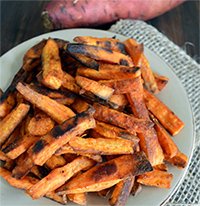 Camotes are healthful (good amounts of complex carbohydrates, dietary fiber and beta-carotene), with moderate contents of vitamin B5, vitamin B6 and manganese. Camotes are by far superior in nutrients than either yams or regular white potatoes.
Camotes are healthful (good amounts of complex carbohydrates, dietary fiber and beta-carotene), with moderate contents of vitamin B5, vitamin B6 and manganese. Camotes are by far superior in nutrients than either yams or regular white potatoes.
A recipe on the net for Camote french fries is summarized here: Peel the Camote and cut them into large or thin fries. Let them soak in water for 30 to 60 minutes; this reportedly brings out all their great flavor and maximizes their nutritional value. Deep fry in a pan like other fried potatoes. Try the fries with limone juice and mayonnaise - zowie!
GG is available if you're cooking Camote fries.
Crocodilian
Any reptile of the order Crocodylia, comprising the true crocodiles and the alligators, caimans, and gavials.
Sandia
Spanish sandía, from Arabic (baṭṭīḥa) sindīyamelon of Sind, from baṭṭīḥa melon + sindīya or melon of Sind. Sind is a region in the northwestern part of the Indian subcontinent. (This one seems like a stretch to GG - Latinos adopted Indian words?)
Ubiquitous
Existing or being everywhere, especially at the same time; omnipresent.
Restaurant "Z", Quepos
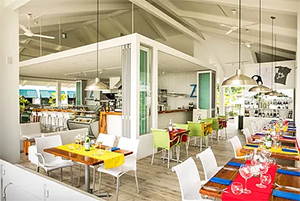 Location: Marina Pez Vela, Second Level, Center
Location: Marina Pez Vela, Second Level, Center
Hours: 7AM to 10PM Everyday
Parking: Ample in Marina Parking Lots
Contacts:Tel.: 2777-6948;
Email: info@zgastrobar.com;
Website: https://www.zgastrobar.com
Reviewing ROMEOS: Bob N., Charlotte H., Dennis R., Glen N., Ingrid H.; Jerry C.; Julia S.
To Review Our Rating System and Procedure, go here: R.O.M.E.O. Rating System
This is the second time we have reviewed "Z" in its current location at the Marina. To read the first review which was some three years ago, go here: "Z" July 2015.
The basic restaurant hasn't changed much in the last three years; its still bright, modern and attractive (despite it being a rainy night when we were there). We were able to secure a large square table that easily seated the seven of us, two sides of which were a padded sofa (GG's back liked that; the chairs also had pads).
The composite ROMEO score for ambiance was 4.0 sloths out of 5.0 possible.
The menu seemed shorter than previously with everything being offered listed on about three medium sized pages. There is a definite slant towards seafood offerings but also a sprinkling of meat and chicken. The plates are still artfully presented as seen in the photo below.
GG decided to go for a full course event and ordered a coconut ceviche (never did detect the coconut in it but it was very flavorful and fresh). I followed that with a carpaccio of tuna which was spiced with jalapeño, an addition I missed on reading the menu so I had to separate out those hot little devils. Both of those courses were not taxing in quantity so I added a piece of chocolate cake (mostly chocolate, little cake - OK by me) with ice cream for desert.
Other ROMEOs ordered various items including a chicken risotto, Cesar and coconut chive salads, shrimp tempura and even a Philly cheese steak.
The composite score for food quality came in at 4.0/5.0 sloths. |
 |
|---|---|
| $$$$.5 | |
Value Index= 93 |
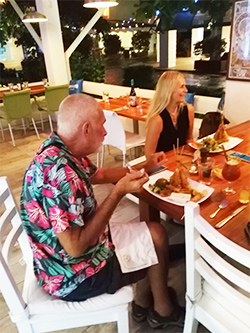 |
| ROMEOs at Work at "Z" |
Service got the highest marks and was offered by a young gentleman named Steven who was friendly, efficient, attentive and helpful. The composite score for service was 4.5/5.0.
For the coconut(less) ceviche, tuna carpaccio, chocolate cake with ice cream, a naturale drink (fresa/piña) to start and a gin(ger ale) machilado with the meal, GG's tab came in at 27,300 colones or about $47.
The group composite score for cost came in at 4.5$ out of 5$ maximum. That yielded a Value Index = 4.2/4.5x100= 93 and places "Z" in the low-central zone for value as compared to other restaurants we've evaluated in the area.
"Z" continues to present an interesting option for creative food, well presented, but be prepared to pay full price.
¡Pura Vida!
The Golden Gringo Chronicles is a free newsletter that is non-political, non-commercial and, hopefully, entertaining. By signing up you will receive an email each month around the first of the month giving you the links to the latest edition as well as to each individual feature and departmental section.
CLICK HERE TO SIGN-UP FOR THE GOLDEN GRINGO CHRONICLES
or Email me at gg@goldengringo.com, or use our Website at: www.goldengringo.com

Bob Normand, Editor
and The Golden Gringo
Pura Vida!
To Contact GGC World Headquarters (yuk, yuk) to make comments, suggest topics or criticize my bad jokes, just send an email to: gg@goldengringo.com.
Be pithy but kind; I'm sensitive.
Unsubscribe from Golden Gringo Chronicles